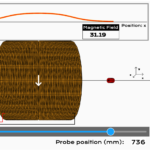Capillary Rise Simulator
Physics is all around us, shaping our everyday experiences in ways we might not even notice. Have you ever wondered how plants draw water and nutrients from the soil? The secret lies in the fascinating principle of capillary rise. Through our interactive simulator, you can now explore this phenomenon firsthand. Adjust the variables, experiment with different conditions, and watch how the liquid climbs in the glass tube. Discover the science behind nature’s wonders — dive in and start experimenting today!
FAQs on Capillary Rise
Qus 1. What is Capillary rise?
Capillary rise is the upward movement of a liquid within a narrow tube or porous material due to surface tension and adhesive forces between the liquid and the surface. It is commonly observed in thin tubes when the liquid climbs higher than its surrounding level, defying gravity. The phenomenon is most visible with water in thin glass tubes.
Qus 2. What factors affect capillary rise?
Capillary rise depends on several factors including:
- the diameter of the tube,
- the surface tension of the liquid,
- the adhesive force between the liquid and the tube surface,
- the cohesive force between the liquid molecules
- the density of the liquid.
Narrower tubes, higher surface tension, and stronger adhesion between liquid and surface are the perfect recipe for seeing capillary rise.
Qus 3. What is the formula for capillary rise?
The formula for capillary rise is:
\( h = \frac{2T \cos \theta}{\rho g r}
\)
where:
- \( h \) is the capillary rise (height)
- \( T \) is the surface tension of the liquid
- \( \theta \) is the contact angle
- \( \rho \) is the density of the liquid
- \( g \) is the acceleration due to gravity
- \( r \) is the radius of the tube
Surface tension is a property of the liquid that describes the elastic tendency of the liquid’s surface. Surface tension directly influences the capillary rise by providing the upward force that counteracts the weight of the liquid column. It acts at the liquid surface and creates a curvature that allows the liquid to rise.
The contact angle (\( \theta \)) reflects the balance between adhesive forces (between the liquid and the solid) and cohesive forces (within the liquid). A smaller contact angle indicates stronger adhesive forces, which allows for a higher rise.
Qus 4. How does tube diameter affect capillary rise?
Tube diameter is inversely proportional to capillary rise. When the adhesive force between the liquid and the surface is stronger than the cohesive force within the liquid, a net upward force causes the liquid to rise. The liquid continues rising until the weight of the liquid above the surface balances this upward force. In narrow tubes, the liquid rises higher because less liquid is needed to counteract the force compared to wider tubes. That’s why, liquids climb higher in narrower tubes as compared to wider tubes.
Qus 5. Why does water rise in capillary tubes but mercury falls?
Mercury doesn’t show capillary rise because its cohesive forces (forces between mercury atoms- metallic bond) are much stronger than the adhesive forces (forces between mercury and the surface of the tube). This causes mercury to form a convex meniscus, leading to a capillary depression rather than a rise.
In contrast, water shows capillary rise because the adhesive forces between water molecules and the glass tube are stronger than the cohesive forces between water molecules (hydrogen bond). This creates a concave meniscus, allowing the water to climb up the walls of the tube.
Qus 6. How is capillary rise measured?
Capillary rise can be measured by placing a thin tube vertically in a liquid and observing the height the liquid climbs within the tube. The height is then compared with the liquid’s level outside the tube. This measurement helps to calculate surface tension and the effects of adhesion between liquid and surface.
Qus 7. What are some real-life examples of capillary rise?
Capillary rise occurs in various real-life scenarios, such as water absorption by plants through their roots and stems, ink rising through the nib of a fountain pen, and liquid climbing up a paper towel. In chromatography, capillary rise helps in separation of chemicals. Capillary rise plays a crucial role in biological systems and everyday materials.
Qus 8. Why does capillary rise defy gravity?
Capillary rise appears to defy gravity due to the adhesive forces between the liquid and the tube surface being stronger than the liquid’s cohesive forces. This creates upward movement in narrow tubes, even against the pull of gravity. Surface tension also plays a key role in this process.
Qus 9. What is the significance of capillary action in plants?
Capillary action is vital for plant survival as it allows water to rise from roots to leaves. Thin tubes within the plant, called xylem, enable the upward movement of water through capillary rise. This natural process helps plants transport essential nutrients and water to all parts of the plant.
Qus 10. Can capillary rise occur in all liquids?
Capillary rise does not occur in all liquids. Liquids with higher adhesive forces compared to their cohesive forces, such as water in glass tubes, exhibit capillary rise. However, liquids like mercury, which have stronger cohesive forces, do not rise but instead form a concave meniscus and fall.



